Dwarf Puffer | A to Z Guide – Care, Tank Mates, Size and Diet
Table of Contents
Overview/Origin

The dwarf puffer fish (Scientific name: Carinotetraodon travancoricus) is one of the best and most exquisite small aquarium fish that aquarists can ever own! Popularly known as the pea puffer fish, this mini-sized freshwater creature thrives in the rivers (and estuaries) of the Western Ghats, Southwest India.
The principal name of the puffer fish has a derivation from an ancient Indian community called the Travancore. Now the place is known to be Kerala, located on the western water coast of the tropical country.
In the fish trade, aquarium owners deem them as one of the smallest puffer fish! You may have heard many names for these tiny but comic-faced fish. Its names are Malabar puffer, pygmy puffer, Indian dwarf puffer, or Peewee puffer.
Unfortunately, their population is now considered vulnerable (VU) to the IUCN Red List because of overfishing and habitat destruction. Reports say that 30% to 40% of their number has decreased from 2005 to 2015.
But no worries! If you are eager to take care of these unique puffers and know where to buy one, you’re good to go.
Pufferfish can cost anywhere from $17 to $60. The price of a pufferfish can vary quite a bit, depending on the size and quality.
One of the most impressive reasons why you should care for these pea puffers is that you will not have any trouble searching for a good tank for them. Because of their cute size, you can even place them in a 5-gallon tank. Now we are not even mentioning that they can be very convenient to keep too!
Appearance

Any owner would describe the features of this bugger to be cute and cartoon-like. One could attribute this foremost to the fish’s face profile. Pea puffers, as their name suggests, looked like odd peas swimming in the water!
Their eyes that are almost half-length their faces and paired with rectangular and bit pointed mouths can give any onlooker the impression that it shows off its queasy faces or quirky looks, even if it is unintentional. No wonder they get a spot in any aquarist’s list of favorites when it comes to fishes with attitude!
Their bodies are nuggety and dense, gracing in hues of green and yellow. They also have black spots in the body and a black stripe in bellies (in males) that makes them seen in the distance despite their size.
The females of their kind are not as vibrant as the males, that’s for sure, but they have more well-rounded bodies than these stocky males.
Pea puffers have very translucent caudal and dorsal fins, too. No wonder they look like swimming without fins!
Behaviour & Temperament
Sometimes the size can be quite deceiving. Our teeny-tiny fish here, unlike the other small tank fishes, is naturally aggressive! They would wander on their big tank messing with other fishes— and would even nip tails. If they are even more confident with their tank, they sure are also active swimmers and look around the tank as if they own it for themselves.
As dwarf puffers do easily get bored, enliven their surroundings with objects that can make them happier to swim, and even make them less wild. Include dense plants and plenty of hiding places for these small fish as these reduce their territorial nature and distract them from chasing other fishes in the tank.
Despite their rather offensive behavior towards other fishes, owners love them for their total temperament. You will notice that they are curious fishes, and they do not let any fish mess up with their territories. But still, they are interesting to watch as they love to swim around their environment and even stare at their owners on one of their quirky faces!
Lifespan
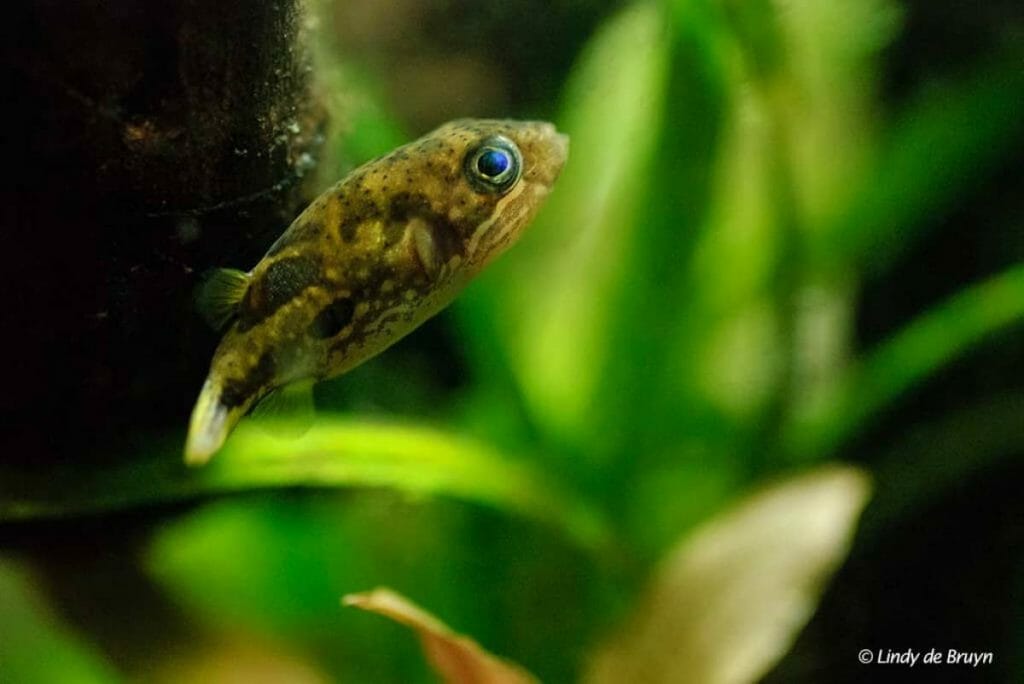
How long does Dwarf Puffer live?
A life expectancy of 5 years or longer is estimated on puffer fishes. Their lifespan also stands true even if they are living in their natural habitat. As an owner, you can set up their tank similar to their original biome to improve the longevity of the fish!
It is best to ensure that proper care and maintenance are well-observed to lengthen the fish’s lives. Remember that this includes but is not limited to a healthy appetite and good water conditions.
Common Diseases
The good thing about dwarf pea puffers is that they are not vulnerable to any species-specific kind of disease! But, they can still be susceptible to any common fish disease known to the aquatic world.
One of the most dreaded diseases of the freshwater kind is the Ich. The illness appears as white spots on the fish’s body. Fishes that have this ailment always tend to rub their bodies on objects or surfaces. If you suspect that one of your fishes suffers from such, you should isolate it to another tank.
Ich is contagious, and your fish can prevent it through regular water cleaning. If you are not wary that any of your fish has the symptoms, then know that it can even wipe a whole tank of fishes!
Water in high-quality promises healthier fishes and less toxicity from bacterial infections. Aim to not resort to subpar water at any given time as this affects the health of the whole tank ecosystem.
Size
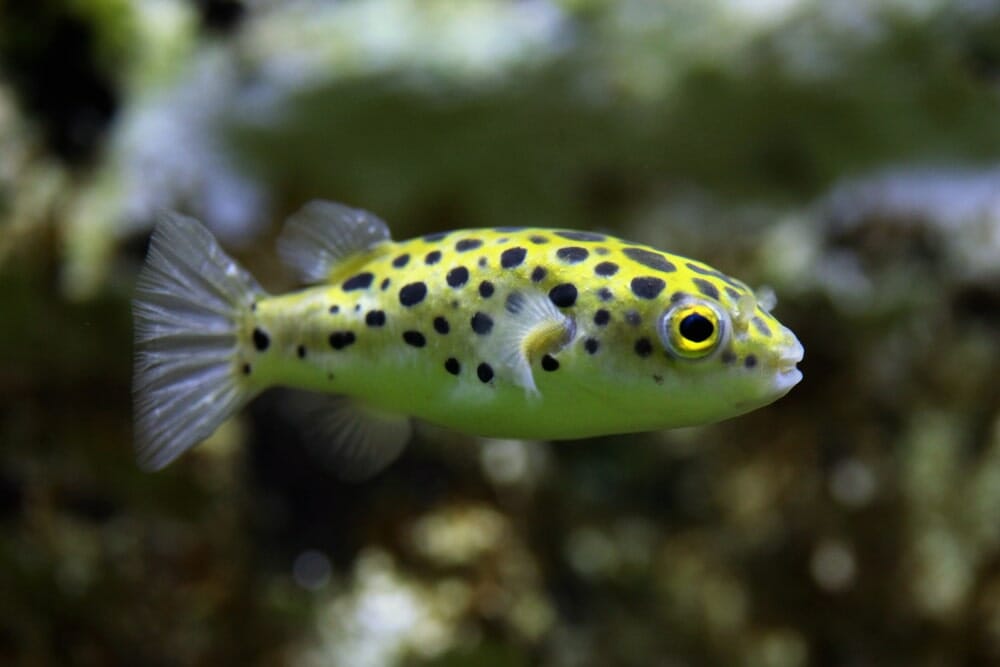
How big do Dwarf Puffers get?
At most, the Dwarf Puffer Fish can only reach the size of 1 and a half inches. Deemed as one of the smallest puffer fish in the world, they do not even exceed the said size even if they matured. Gender does not affect their size a lot or even their genes, at that matter.
You might wonder if thorough caring can contribute to adding body size. Unfortunately, it doesn’t! This impeccable small size of the Dwarf Puffer fish makes it even more fascinating among aquarists, as its measure complements its quirky character.
How many Dwarf Puffers can be kept together?
Due to their nippy behavior, pea puffers are best in tanks that are made only for them. If you would like to bring more than one pea puffer fish to the aquarium, it is preferable to have only one male in the crowd.
Female ones are less aggressive, and some owners would even want an all-female group of five or less. Well, this is especially true for those that wanted to take other fish species to the tank.
Pea puffers would always love to nip on anything that they are interested in, and they do this even to non-living objects as their way of preying. So be cautious about the number of puffer fish that you put together in your tank!
Dwarf Puffer Care
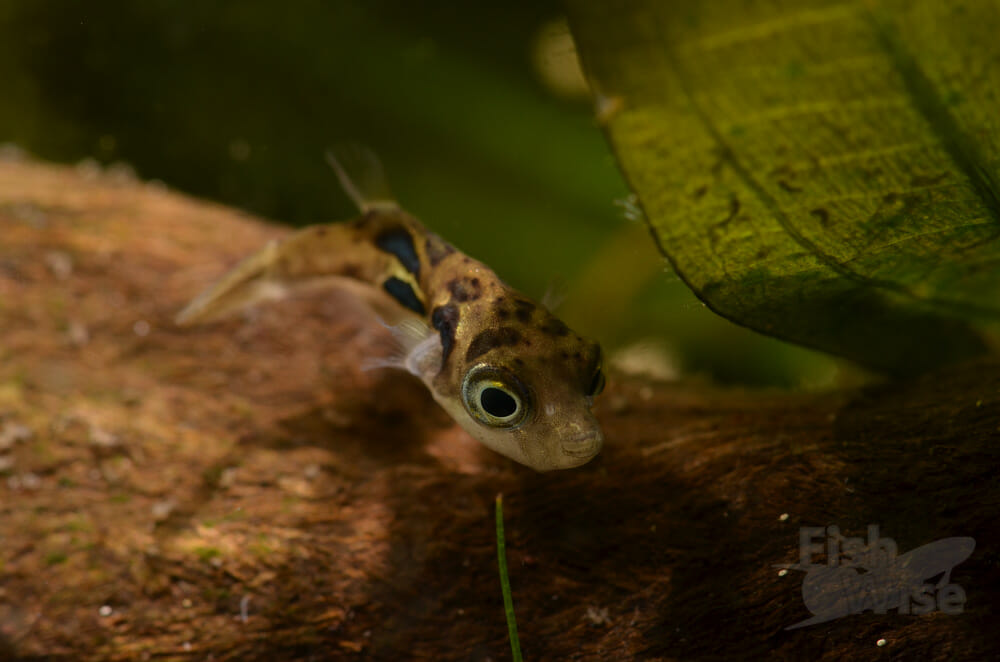
Tank Size
It is better to have a tank size that can handle 10 gallons of water. A roomy tank for small fishes will be a good sign for them to roam more and never get bored inside the tank. More water can even be more beneficial if there are other fish species in the tank. If your other fishes have a safe space from the territorial dwarf puffers, they will get stress-free and even bite-free!
Over time, if you get to have more dwarf puffer fishes in the tank, make sure that extra space of 5 gallons per fish is allotted. That is not only for them to feel less stressed amid other tank fishes but also to make them less territorial!
If you like, maximizing the water range to 30 gallons is excellent too. Buying a tank that can handle a lot is better if you want your fishes to achieve more of an infection-immune body and quality life.
Tank Setup
As small and hyper fishes, pea puffers may want to explore a tank filled with vegetation and unusual objects. Placing a lot of possible hiding places will also make these fishes enjoy the tank!
First off, to put in their home are dense, leafy plants that occupy plenty of areas in the tank. They will feel safe and secure in floating aquarium plants, hornwort, or any rooted ones. Indeed, plants reduce stress on pea puffers or any freshwater fish that may feel threatened from time to time.
Add more brilliant decorations to the tank by taking in cave-like rock and driftwood such as rhododendron and manzanita. Mesquites are also a perfect type of driftwood if you are into aesthetic aquascaping. These not only give a natural effect to any tank, but they provide a nice getaway for your curious fishes!
In usual tank settings, a sand substrate is still the best choice. It is appealing to onlookers and provides a good foundation for the water plants. Of course, choosing coarse gravel can also do if you want to add uniqueness to the puffer fish home!
An excellent filtering system helps manage your tank water’s cleanliness. It can aid your puffer fish that can get sensitive too in slight changes of the water state. Other items such as a high-quality temperature monitor are handy for your tank, too.
Water conditions
The owner must be able to practice a good habit of monitoring the water standards all the time. The tank water must conform to the needed requirements where dwarf puffers were most likely to thrive for a longer time. The following are the guidelines that can serve as your criteria:
- Water temperature: With the small bodies of dwarf puffers, they can easily sense any slight heat changes in the water. A consistent temperature ranging from 72°F to 82°F is what you have to know.
- pH levels: The acidity level should also be averaging 7 to 8 pH, like in the water condition that dwarf puffers have gotten used to.
- Water hardness: Mind also that 5-15 KH of water hardness is adjusted even after changing the water inside the tank.
Regardless of the fish species you let join with the dwarf puffers, always try to maintain your assessment in the water condition to satiate every fish’s needs. If you like, having a handy water test kit can also be a great aid to you for balancing the water in the long run.
Diet & Feeding
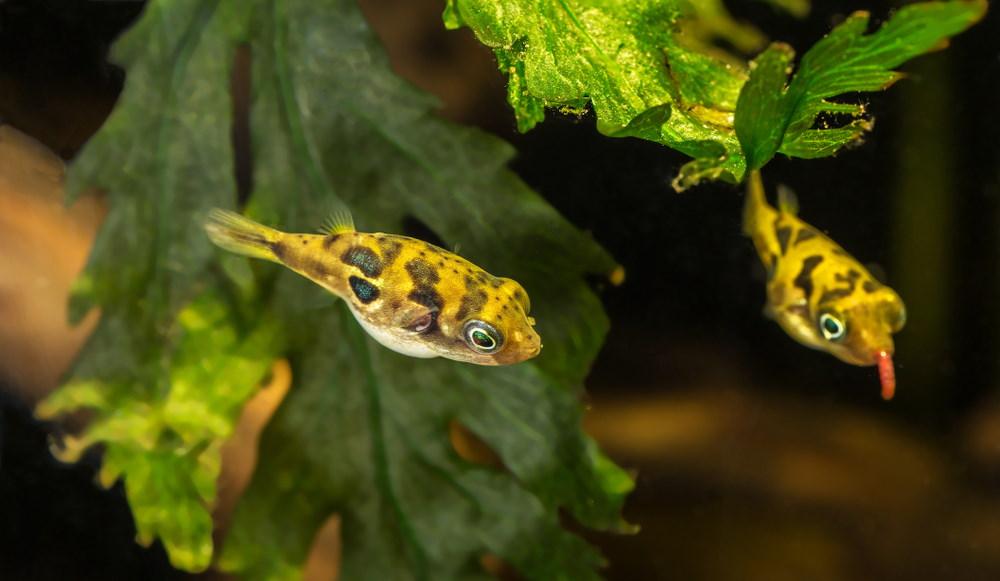
What do Dwarf Puffers eat?
Dwarf puffers may have a small size, but it does not mean that they eat small! As carnivorous fishes, owners should give them a lot of protein-based foods:
- Tubifex
- Brine shrimp
- Mysis shrimp
- Bloodworms
- Any frozen and live foods
In their ecosystems, puffer fishes also consume insect larvae such as the mosquito. They will not skip snails or daphnias that are lurking on their scope, so adding these to their food list would be a joy to them!
Giving a variety of quality plant and live food is still okay and even sustains good health for your fishes. By the way, pellets and flakes are not delectable to them, so settling on these fish foods should not be your go-to if you are looking for other food substitutes.
How often should I feed my Dwarf Puffer?
Feeding the fish two times a day is advisable. Once during the day, and one at night. If you have larger or adult ones in the tank, sometimes you can even try to serve them food to eat every other day. If there are young underlings in the tank, those are the ones that need more binge-eating!
There are options on feeding the pea puffers, too. You may even get a small number of live food, such as snails, for the fish to prey on whenever they feel at it.
Puffer fishes do not need to be overfed, as their bodies do not grow as much, unlike other tank fishes. Small portions of food consumed in only three minutes would suffice for their tummies.
How long can Dwarf Puffer go without food?
In the wild, dwarf puffers can survive with no food for up to two weeks at most. But in captivity, leaving them without anything to eat should be treated with more care.
Being predatory by nature, blowfishes such as the dwarf puffer can go for a week with no regular serving of food. An owner can do this if live food is made available in the tank, such as snails.
Also, be wary if you are leaving the puffers with other fish species in the tank. Extra caution on feeding must be available if there are younger ones in the tank, too. Puffer fishes are fiendish as they prey for food, and as a result, they may try to bite chunks from their fellow swimmers if they went hungry in no time.
Tank Mates
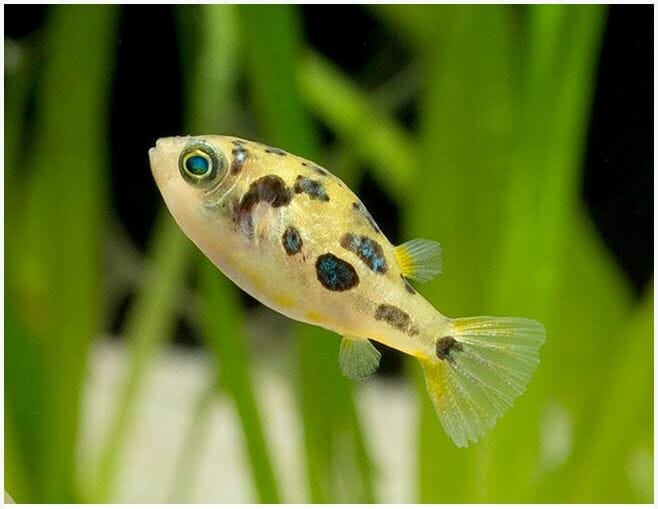
Can dwarf puffer fish live with other fish?
As natural carnivores, letting your dwarf puffer fishes go along with other fishes will be hard to do. Even internet sources will tell you to put your fish in an exclusive tank instead!
Yet, these critters are shoaling fishes, meaning they still love to be in the company of other fishes, too.
Providing a larger tank with many plants that can serve as great partitions between fishes can help. You can place other fishes on the tank if you have set it up in a tactical way (e.g., bringing more water to the tank to avoid invading each other’s spaces).
Still, you must proceed with caution as there is a low success rate in getting pea puffers to live in the same hood as other fish species.
What fish can live with Dwarf Puffer?
There is no particular tank mate that is suitable for dwarf puffers. In most cases, they are kept by most fish owners in tanks where no other fish species thrive! Only if you want to see a bloodbath in your aquarium at the end of the day, but still, the best advice is to create a tank made for their kind alone.
If you still like to go the extra mile and get a companion for this fish, there are some high-maintenance species that can handle the aggression of the fin-nipper. These are the following:
- Dwarf suckermouth catfish (Genus: Otocinclusescape)— Fish owners take extra caution after purchasing a dwarf catfish as these aquatic creatures have a high mortality rate when transferred to a different environment. They are known to be one of those fishes that clean tanks as they love to eat green algae. Matched to the behavior of the dwarf puffer fish, they are frantic swimmers and this especially happens when they sense trouble.
- Cherry Shrimp— Comes in different color grading, this one munches on algae too and can be a good addition to the tank given that it is much larger than the dwarf puffer. They float on the water surface, most of the time.
What fish don’t do well with Dwarf Puffer?
Many fish owners always try to test which fishes can be compatible with the dwarf puffers. The following had been handy to them:
- Avoid bringing slow-moving fishes in a tank with a dwarf puffer in it. It may not look like it, but the puffer fish is a fast-catcher, and with their beak-like mouths, they can even bite on other fish’s bodies with no to less effort at all.
- The same goes with larger fishes. Size doesn’t matter to this pea puffer as their curiosity makes them eat almost anything they see as food.
Breeding
If you plan to rear more dwarf puffers, you should get to know the sexes of the adult pair ready to breed first. After all, breeding for their kind will not be too difficult for anyone who will take this hobby!
For you to see if an adult male and female are sexually mature, you should notice that they are more vibrant in color, with females being more rounded in their bellies too. Males, on the other hand, love to go frequently to hidden areas of plants. They would most likely look for parts with Java moss in it.
In prepping up the pair, it must begin with the tank conditions. The tank must be clean enough for the adult’s fry to adjust in. Water heat is sustained in an ideal temperature range for successful mating too.
Given the best water parameters, the pair that you have can naturally proceed to mate with the male following around the female one.
Within a week, eggs laid by the female will be tended by the male for a while. These eggs are most likely to be on the soft moss (e.g., Java moss), and for a week or two, the fry will soon start to swim in the water, but not long after the male adult has left the hatched eggs.
Note: Once the spawning process is okay, the owner should remove the adult pair from the tank to ensure that both will not eat the new hatch.
You can try feeding the new fry with live food, such as microworms, once they are already free-swimming. You will also observe that the fry grows fast, and by two months, they can be at least a centimeter in length!
Summary
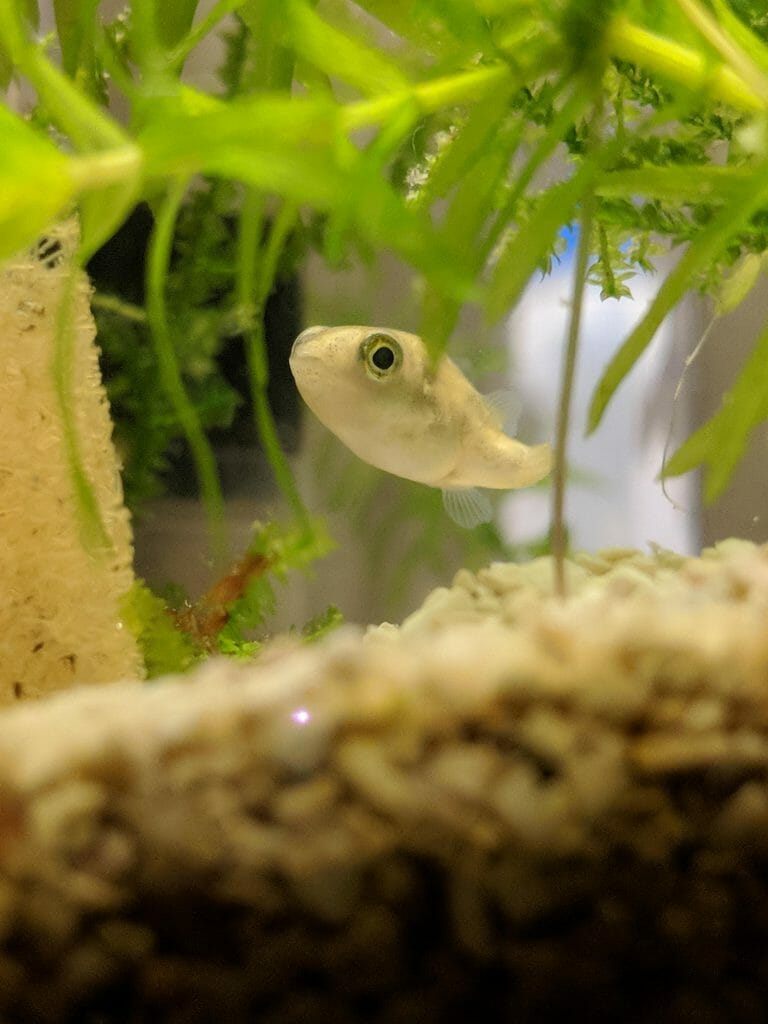
Are Dwarf Puffers easy to care for?
Any owner would agree that Dwarf Puffers are not that difficult to keep. The fish is a natural predator, and so they can always find something for themselves to munch on! If, in any chance that they would not be able to eat food served by their owner, they can always choose to eat even the growing algae in the tank.
The care for this tiny squabble fish is generally enjoyable, too! It is not a hidden fact that they are intelligent and would even react to their approaching owner when they know one thing is coming –food! Their comic behavior (despite their ugly reception towards other tank fishes) makes them a lovable character for any fish enthusiast!
Dwarf puffers do not also go in groups, making them easier to buy and tend after. At first, they may shy away from the surface if they are new in the tank. But as the days go, they will start to show their active behavior! From trying to hide behind rocks or plants to impressing you even by looking at you to give it food!